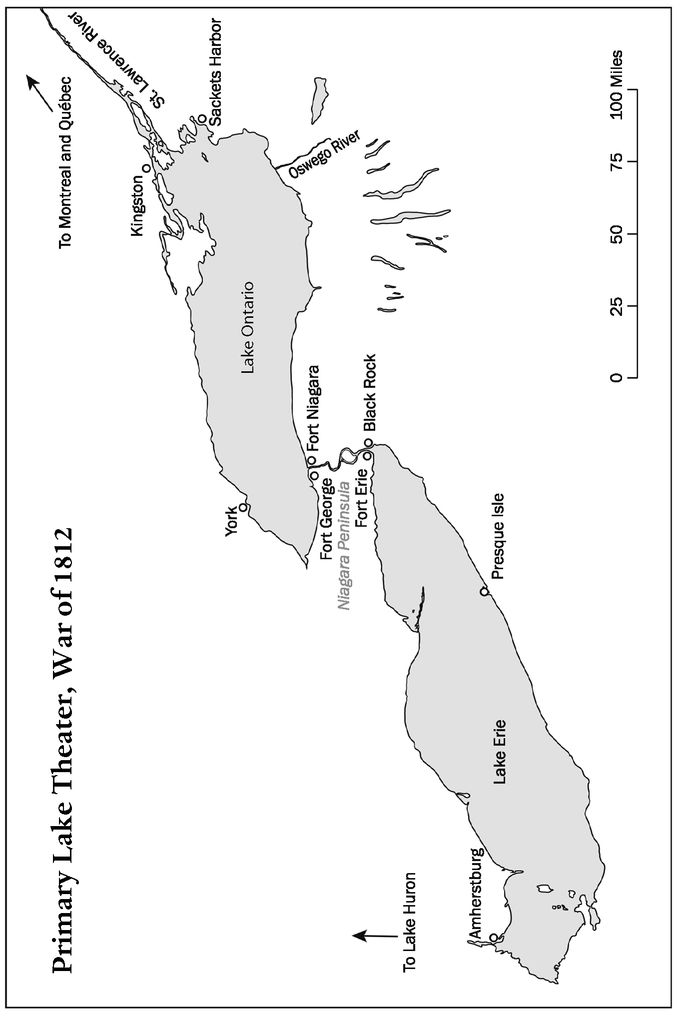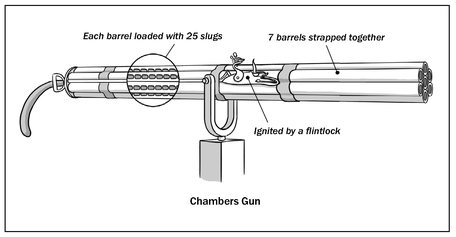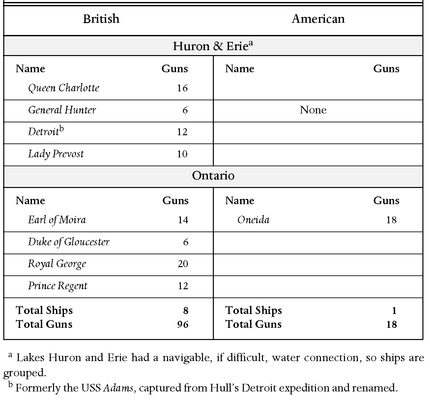The Dawn of Innovation (3 page)
Read The Dawn of Innovation Online
Authors: Charles R. Morris


The shipbuilders' war lasted for two and a half years. Both sides constructed substantial cities at their primary bases near the mouth of the St. Lawrence. The British base at Kingston, on the north shore, was a thirty-mile sail from the American base on the opposite shore, at Sackets Harbor. By war's end, each was able to house and feed some 5,000 semipermanent residentsâseamen, marines, and their officers; shipwrights, smiths, and other craftsmenâplus massive ship factories and associated shops, as well as facilities for short-term feeding and support of the thousands of infantrymen mustered from time to time for amphibious operations.
It was easy to underestimate the challenges of the lakesâon maps they looked like mere puddles. But winds were highly variable, and violent storms sprang up almost without warning. (Shallow waters often generate the most violent storms; ocean depths absorb the force of surface disturbances.) The lakes' heavy fogs and frequent squalls, and the near-constant presence of a lee shore, jangled captains' nerves. On Lake Huron, an American captain found himself “embayed in a gale of Wind on a rocky Ironbound shore . . . shipping such immense quantities of water as to give me very serious alarm for some hours.” The whole coast, he said, was “a steep perpendicular Rock” and navigation “extremely dangerous . . . falling suddenly from no soundings into 3 fathoms [18 feet] & twice into ¼ less twain [10½ feet].”
8
8
The challenge was to build “weatherly” fighting ships fast and cheaplyâcutting corners without compromising performance. Ships built of unseasoned wood go to rot within just a few years, so many finishing
details could be dispensed with. With no need to carry water or long-term supplies, they had smaller holds and shallower drafts, enabling close approaches to shore. The American ships especially carried large expanses of sail and heavy gunnery for their size. For example, to the British the American
Pike
was a difficult sailer, but in the hands of an expert crew, it was among the quickest and most maneuverable warships on the lakes.
details could be dispensed with. With no need to carry water or long-term supplies, they had smaller holds and shallower drafts, enabling close approaches to shore. The American ships especially carried large expanses of sail and heavy gunnery for their size. For example, to the British the American
Pike
was a difficult sailer, but in the hands of an expert crew, it was among the quickest and most maneuverable warships on the lakes.
Chauncey's orders were the kind commanders dream of. He was “to obtain control of the Lakes Ontario & Erie, with the least possible delay.... With respect to the means to be employed, you will consider yourself unrestrained [and] . . . at liberty to
purchase
,
hire
or
build
, such [vessels] . . . of such form & armament” as he chose.
9
purchase
,
hire
or
build
, such [vessels] . . . of such form & armament” as he chose.
9
His prize acquisition was Henry Eckford, one of the age's great naval architects and owner of a private shipyard in New York. He turned out to be a master of improvisationâas in devising easier-to-build bracings for ships with short shelf lives. Old hands expected Eckford's ships to break in two when they were launched down the slipway, but all of them performed well. Backing up Eckford were the Brown brothers, Noah and Adam, who also operated a New York boatyard. The Browns designed and built the ships on Lakes Erie and Champlain, and worked so smoothly with Eckford on Ontario that scholars have difficulty in distinguishing their work from his.
The British building program was supervised mostly by William Bell, a Canadian who had run a boatyard on Lake Erie, and later by Thomas Kendrick, an experienced naval architect from London. A senior British officer, Capt. Richard O'Conor, was assigned full-time to manage the yards. Both sides achieved rapid construction schedules, although fully masted ships often sat at shipyard docks for weeks or months waiting for critical components, like cannon or ship's cable.
Chauncey was also something of a gadgeteer. His fleet usually had between a dozen to sixteen of its long guns on swivels, so they could be deployed on either broadside. He also experimented with rapid-fire weapons, known as Chambers guns, after their Philadelphia inventor. A British spy described them as having: “seven barrels . . . throw[ing]
250 balls at each fire . . . [with] one Lock & the fire is communicated fm. Barrel to Barrelâ& they discharge successively at the Interval of one Second.”
10
250 balls at each fire . . . [with] one Lock & the fire is communicated fm. Barrel to Barrelâ& they discharge successively at the Interval of one Second.”
10
Wars turn on logistics. In the shipbuilders' war both sides had endless supplies of timber for the taking but had to import virtually all tools and nonwooden materials, like rope, ordnance, iron fittings, and shot. The Americans had decent river and canal transport from New York City to the port of Oswego on Lake Ontario, although it required some portages. For Lake Erie there was inland ground transport from Philadelphia and Pittsburgh, but in that era, almost all roads were execrable most of the time. An artillery major bringing cannon from Pittsburgh in the early winter of 1813 wrote of days at a stretch when they were “with our horses to their middles in mud and water.”
11
Even in the dry summer of 1812, Chauncey lost whole cannons when wagons overturned in a mire.
11
Even in the dry summer of 1812, Chauncey lost whole cannons when wagons overturned in a mire.

The Chambers Gun was a fusillade weapon, firing a hail of cylindrical slugs. Ignition was by single flintlock in front, and was communicated from barrel to barrel through touch holes and a roman-candle-type fuse. The firing spark also traveled backward through the slugs by fuses that ignited powder packed throughout the column. The guns were said to be rapidly loaded. It is possible that the slugs, powder, and fuses were prepacked in copper tubes that could be loaded and extracted rather like modern ammunition clips.
For the British, it was actually an advantage to source supplies from England, since ship transport from Portsmouth to Montreal was fast and reliable, while bateaux transport to Lake Ontario took only a few days. The problem was getting from the lake entrance to the British base at Kingston. When the lake was under American control, a war schooner or two sitting at the mouth of the St. Lawrence stopped the British supply train cold. In periods when the lake was contested, the trip required military escort, and jam-ups of cargo bateaux awaiting escort could stretch for miles. Overland transport was a poor option: some supplies could get through, but not enough to sustain a burgeoning military presence. British food requirements were magnified by the Indian alliances, for the tribes quickly learned the advantages of takeout service from the British mess. One commander wrote in alarm to headquarters in 1813, “The quantity of Beef and flour consumed here is tremendous, there are such hordes of Indians with their
wives
and
children
.”
12
Chauncey Rules Ontario: October 1812 to May 1813wives
and
children
.”
12
Within weeks of his appointment, Chauncey started a massive caravan of shipwrights, mechanics, sailors, marines, ordnance, and supplies on the road to Sackets Harbor. Eckford went with the earliest groups to start laying out construction plans. Militarily, they were starting almost from scratch (see
Table 1.1
).
13
Table 1.1
).
13
By mid-November, Chauncey and Eckford had built a naval yard and dry dock and facilities for 1,000 men and officers. The
Madison
, a graceful, new 24-gun corvette, or subfrigate, was launched on November 26, just forty-five days from starting its keel. By that time, Chauncey had also bought up a number of lakers, local transport workhorses. He netted several modest schooners, which were slow but could carry up to 10 guns, and some smaller gunboats with both sails and rowing stations. Outfitted with 1 or 2 long guns, the gunboats could pose a real threat to shoreside troops or to a becalmed warship. Also in May, a daring long boat raid on Lake Erie, led by Lt. Jesse Elliott, cut out and burnt the
Detroit
and captured a gunboat, the
Caledonia
.
Madison
, a graceful, new 24-gun corvette, or subfrigate, was launched on November 26, just forty-five days from starting its keel. By that time, Chauncey had also bought up a number of lakers, local transport workhorses. He netted several modest schooners, which were slow but could carry up to 10 guns, and some smaller gunboats with both sails and rowing stations. Outfitted with 1 or 2 long guns, the gunboats could pose a real threat to shoreside troops or to a becalmed warship. Also in May, a daring long boat raid on Lake Erie, led by Lt. Jesse Elliott, cut out and burnt the
Detroit
and captured a gunboat, the
Caledonia
.
Â
TABLE 1.1
Naval Forces on the Lakes: September 1812
Naval Forces on the Lakes: September 1812

Even better, once Chauncey took the
Oneida
out on the lake, he discovered that the Provincial Marine, which was trained as a security service, didn't fight. He began to attack British shipping at every opportunity, taking several prizes, and at one point chased the
Royal George
all the way into Kingston. Even without the
Madison
, he could truthfully report that he had “command of the Lake” and could transport troops and stores anywhere “without any risk of an attack by the Enemy.”
14
Oneida
out on the lake, he discovered that the Provincial Marine, which was trained as a security service, didn't fight. He began to attack British shipping at every opportunity, taking several prizes, and at one point chased the
Royal George
all the way into Kingston. Even without the
Madison
, he could truthfully report that he had “command of the Lake” and could transport troops and stores anywhere “without any risk of an attack by the Enemy.”
14
The lakes were icebound in winter, which facilitated troop movements and led to more American disasters. An American offensive in the
Detroit area ended with a large detachment being “cut to pieces.”
15
American prisoners were later massacred by a party of Indians near the River Raisin: “Remember the Raisin” became an American rallying cry. The British cemented their control of the St. Lawrence by capturing the town of Ogdensburg. The Americans fended off an attack at Ft. Meigs, on the Detroit River, but lost almost all of an American relief force, some of whom were also massacred by Indians.
Detroit area ended with a large detachment being “cut to pieces.”
15
American prisoners were later massacred by a party of Indians near the River Raisin: “Remember the Raisin” became an American rallying cry. The British cemented their control of the St. Lawrence by capturing the town of Ogdensburg. The Americans fended off an attack at Ft. Meigs, on the Detroit River, but lost almost all of an American relief force, some of whom were also massacred by Indians.
In Washington, there was a shake-up in the military departments. John Armstrong, a former senator and ambassador with presidential ambitions and a reputation as a strategist, took over the war department. He proved to be an intriguer and a windbag with an unparalleled gift for sowing confusion. The new naval secretary, William Jones, was a former shipwright who had risen to head a large merchant house. His dispatches were informed, crisp, and intelligent. As the tightening British coastal blockade kept the Atlantic fleet locked in port, he started transferring their crews to the lakesâamong them a fast-rising young naval captain, Oliver Hazard Perry, who joined Chauncey with 150 men and was given command of Lake Erie, with Lt. Elliott as his second.
Chauncey was back on Lake Ontario with the first thaw. In late April he coordinated an attack on York, the provincial capital (and present-day Toronto), where the British were constructing a major new warship. Chauncey took his whole fleet: the
Madison
, the
Oneida
, and eleven lakers, wallowing with the weight of 1,700 ground troops.
Madison
, the
Oneida
, and eleven lakers, wallowing with the weight of 1,700 ground troops.
York was defended by British regulars, but the beach assault came off briskly, as the warships silenced York's artillery. Within a couple of hours, the British were in retreat, the new warship was burnt, the
Duke of Gloucester
taken, and large amounts of stores captured, all with light casualties. An easy victory turned to disaster when an arms magazine that had been mined by the retreating British blew up next to the main American infantry group. Gen. Zebulon Pike, the American infantry commander, and another 38 soldiers were killed, with 221 wounded. Technically, the action met its objectives, but the butcher's billâ320 casualties in allâwas grossly disproportionate.
Duke of Gloucester
taken, and large amounts of stores captured, all with light casualties. An easy victory turned to disaster when an arms magazine that had been mined by the retreating British blew up next to the main American infantry group. Gen. Zebulon Pike, the American infantry commander, and another 38 soldiers were killed, with 221 wounded. Technically, the action met its objectives, but the butcher's billâ320 casualties in allâwas grossly disproportionate.
A month later, Chauncey took the fleet to Niagara for an attack on Britain's Ft. George. A 4,000-man army, with promising new second-rank commanders like Winfield Scott, was assembled and waiting for naval support. Once again, the beach assault went like clockwork, as warships poured grapeshot into the defenders and pounded their artillery emplacements. By ten AM, with the fort in flames and the
Madison
disgorging yet more fresh troops, the British commander sounded a withdrawal. The army then quickly rolled up the rest of the peninsula, including the British outpost at Ft. Erie. Both expeditions were striking demonstrations of the potential of combined-arms operations on the lakes.
Madison
disgorging yet more fresh troops, the British commander sounded a withdrawal. The army then quickly rolled up the rest of the peninsula, including the British outpost at Ft. Erie. Both expeditions were striking demonstrations of the potential of combined-arms operations on the lakes.
Other books
Bone and Jewel Creatures by Elizabeth Bear
Yours Until Dawn by Teresa Medeiros
Unbroken by Paula Morris
Behind That Curtain by Earl Der Biggers
Basic Training by Kurt Vonnegut
Hungry for More (2012) by Chelsea Scott, D. Oland, J. Welch
Skin and Bones by Tom Bale
The Tropical Issue by Dorothy Dunnett
Brock by Kathi S. Barton
Angel Tormented (The Louisiangel Series Book 3) by C. L. Coffey